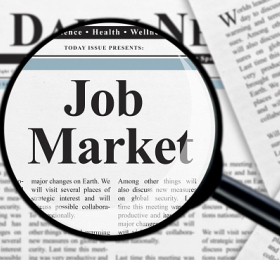
December 8, 2023
We are in the “thrill zone” for the Powell Fed—whispers of a soft landing are getting louder. Nonfarm payrolls increased by nearly 200K in the penultimate month of ‘23 with the official unemployment rate declining to 3.7% (U6 is 7.0%). Hiring among women and teenagers stand out in the November data. Meanwhile, October JOLT’s (8.73M) indicated a sharp reduction in demand for American labor to start Q4. This ties with a rather substantial downshift in overall domestic economic activity that has been seen in various data points over the past few weeks. Moreover, commodities in the energy complex have been under significant pressure lately with WTI briefly breaking below $70/ bbl and natural gas hovering just north of $2.50/ mcf. According to the Atlanta Fed, the US is on track to expand at an annualized rate of 1.2% in the final three months of the year—a marked slowdown from the torrid pace set during Q3. On the whole we appear to be finding some economic equilibrium!
As is typical for those managing assets, we round out the year with a look back and a look forward. Let’s start with the big picture: 2023 likely marks the end of the Federal Reserve’s most ambitious rate hiking cycle in nearly two generations. The terminal rate is effectively 5.33%, which is >2X the highpoint of the last cycle which ended in 2019 (also under the stewardship of Jay Powell). In relative financial terms this is like comparing Mt. Everest to Pikes Peak! Suffice it to say these cycles were very different. The dynamics underpinning the structural shift in rates will impact financial and economic decisions for years to come. This will naturally impact the investment landscape—we have gone from essentially living at sea level (zero interest rate policy) to an alpine equivalent last encountered in 2007. The challenges and opportunities will be different from here. After all, when an obstacle like “Powell’s Peak” presents itself, an investor has little choice but to scale it.
Earlier in the year we spent several months discussing debt/ leverage and illustrating its impact on growth (ROE). The use of “healthy leverage” is an incredibly important concept to ANY investor, and the conversations we had with clients following those posts have been very enlightening and valuable to us as managers and fiduciaries. In most cases the concept of “managed debt” as a return amplifier and source of liquidity rather than a drain on liquidity (and/ or “financial burden”) allowed us to deepen existing relationships/ partnerships, broaden opportunity sets, and enhance investment spectrums. We are grateful to those that reached out over the past few months and would be glad to discuss this “tool” in the future for anyone interested.
Our process is predicated on stability, liquidity, and growth. Over the past couple of years we tilted portfolios to emphasize stability and liquidity as we navigated an incredibly challenging (and at times frustrating) investment landscape. An important point that we have shared with clients over the last 24 months is that when economics change (as they have) and markets shift (as they did), the best way to adapt is via liquid assets (those that actually trade). No one knows how long a particular investment environment will persist or how quickly it will diminish (just ask one of the most prolific doomsayers in the investment space, Jeremy Grantham). Liquid assets provide the rational investor with an opportunity: to alter risk exposures and manage economic changes. Illiquid assets almost by definition cannot offer the same benefit, BUT they can offer greater returns over time. So, we have had many discussions over the course of this hiking cycle about how to access and incorporate these sorts of opportunities into a more comprehensive investment plan. It is also worth noting that we pointed out during the pandemic that cycles could become increasingly volatile and compressed in the future. Markets are certainly trading that way these days and that only heightens the importance of liquid assets for investors in the present and the years to come.
We are cautiously optimistic that earnings growth in corporate America can return to double digits next year after what has been essentially a pause in 2023. Absent a recession or flare up on the inflation front that consequently forces the Fed’s hand, we are positioned to return to a more “growthy” stance. Frankly it would be nice to play a little offense after so much time in the trenches! We are sticking with our prior estimate that 2024 operating profits will come in at ~$242/ share on the S&P 500. The big question is how long the Fed holds rates at the current level. Much of the tightening that took place in the fall has unwound in recent weeks. Thus far Q4 data indicate a significant amount of slowing in the domestic economy after lurching forward at an astonishing rate during the summer months (strong vs out of sync). So, it is not surprising to see equities rally toward their August highs on hopes for economic equilibrium in lieu of reacceleration. This is certainly a benign development, but we remain reluctant to change our view on rate cuts in the first of half of next year (S&P 500 current fair value, 4575). The back half of ’24 seems more plausible, and even in that case we don’t see an argument for drastic cuts so long as the economy and labor market remain resilient, which is our base case. We wish you a happy holiday season, and we will see you in ’24!
News Release: Bureau of Labor Statistics (The Employment Situation- November 2023)
